Mulesoft MuleSoft Certified Developer-Level 1 MuleSoft Certified Developer-Level 1 (Mule 4) Online Training
Mulesoft MuleSoft Certified Developer-Level 1 Online Training
The questions for MuleSoft Certified Developer-Level 1 were last updated at Dec 14,2025.
- Exam Code: MuleSoft Certified Developer-Level 1
- Exam Name: MuleSoft Certified Developer-Level 1 (Mule 4)
- Certification Provider: Mulesoft
- Latest update: Dec 14,2025
Why would a Mule application use the ${http.port} property placeholder for its HTTP Listener port when it is deployed to CloudHub?
- A . Allows CloudHub to automatically change the HTTP port to allow external clients to connect to the HTTP Listener
- B . Allows CloudHub to automatically register the application with API Manager
- C . Allows MuleSoft Support to troubleshoot the application by connecting directly to the HTTP Listener
- D . Allows clients to VPN directly to the application at the Mule application’s configured HTTP port
A
Explanation:
This helps CloudHub to dynamically allocates a port at deployment time. MuleSoft Doc
Ref:
https://docs.mulesoft.com/mule-runtime/4.3/deploy-to-cloudhub#prerequisites
https://docs.mulesoft.com/runtime-manager/developing-applications-for-cloudhub
A REST connect module is generated for a RAML specification. and then the rest connect module is imported in mule application in Anypoint Studio.
For each method of the RAML specification, what does the REST connect module provide?
- A . A scope
- B . A flow
- C . An operation
- D . An event source
B
Explanation:
Correct answer is an operation. For each method of the RAML specification, REST connect module provide an operation.
Please refer to the below screenshot.
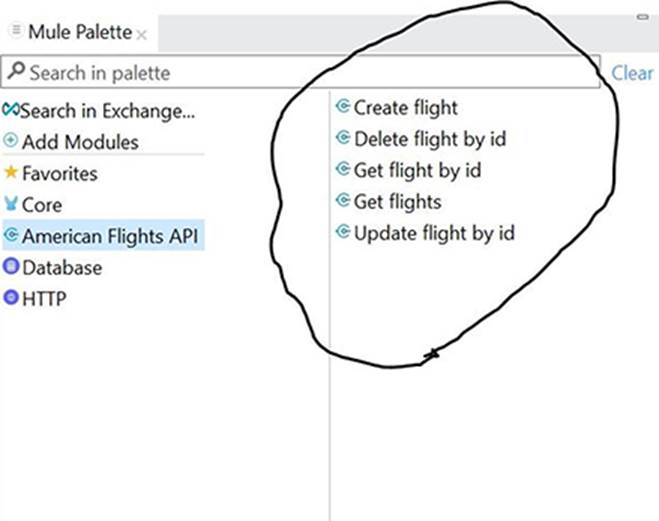
A company has an API to manage purchase orders, with each record identified by a unique purchase order ID. The API was built with RAML according to MuleSoft best practices.
What URI should a web client use to request order P05555?
- A . /orders/{P05555}
- B . /orders/order=P05555
- C . /orders?order=P05555
- D . /orders/P05555
Refer to the exhibits.
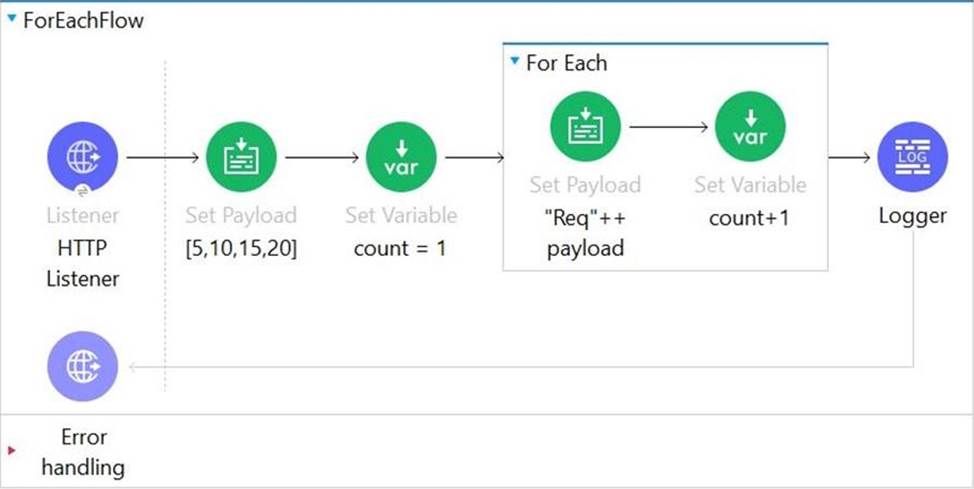

What payload and variable are logged at the end of the main flow?
- A . [[5, 10, 15, 20], 1]
- B . [[5, 10, 15, 20], 5]
- C . [[Req5, Req10, Req15, Req20], 5]
- D . [Req5Req10,Req15Req20, 5]
B
Explanation:
Correct answer is [[5, 10, 15, 20], 5]
Key thing to note here is that any changes made to payload in for each loop are not available outside for each scope where as variable value updated in for each loop is visible out side for each loop too.
Which of the below is not a valid category for connector type?
- A . Gold
- B . Select
- C . Premium
- D . Community
A
Explanation:
Gold is not valid category for connector types.
MuleSoft Doc
Ref: https://docs.mulesoft.com/mule-runtime/3.7/anypoint-connectors#connector-support-categories
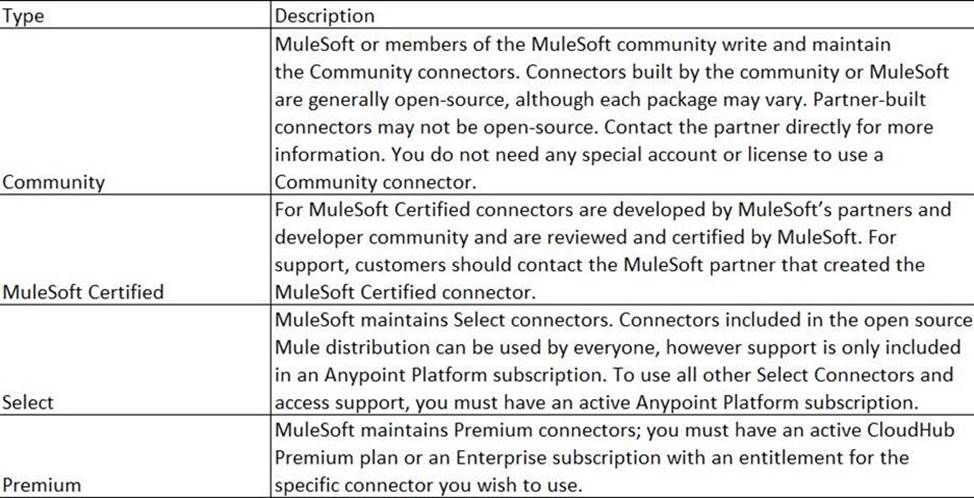
Text
Description automatically generated with medium confidence
Refer to the exhibit.

What is the output payload in the On Complete phase?
- A . summary statistics with NO record data
- B . The records processed by the last batch step: [StepTwol, StepTwo2, StepTwo3]
- C . The records processed by all batch steps: [StepTwostepOnel, stepTwostepOne2, StepTwoStepOne3]
- D . The original payload: [1,2,31
A
Explanation:
This is a trcik question. On complete phase pyalod consists of summary of records processed which gives insight on which records failed or passed. Hence option 4 is correct answer
MuleSoft Documentation
Reference: https://docs.mulesoft.com/mule-runtime/4.3/batch-processing-concept#on-complete
Refer to the exhibits.
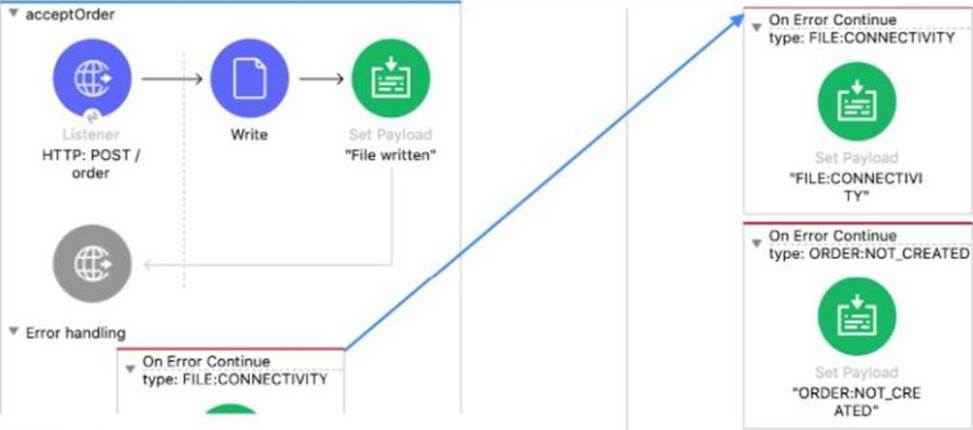

The Mule application does NOT define any global error handlers.
A web client sends a POST request to the Multi application with this input payload The File Write operation throws a FILECONNECTIVITY error
What response message is returned to the web client?
- A . "ORDER NOT_CREATED"
- B . "OTHER ERROR"
- C . "File written"
- D . "FILECONNECTIVITY"
Refer to the exhibits.
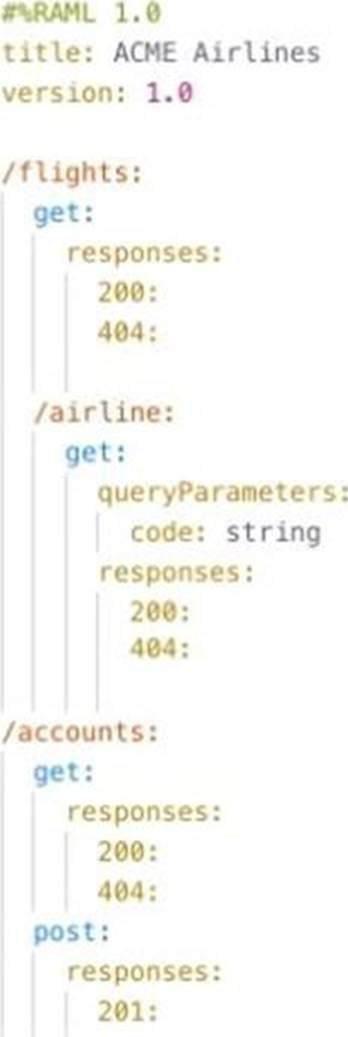
How many private flows does APIKIt generate from RAML specification?
- A . 1
- B . 2
- C . 3
- D . 4
D
Explanation:
APIKIt Creates a separate flow for each HTTP method. Hence 4 private flows would be generated.
MuleSoft Documentation
Referrence: https://docs.mulesoft.com/mule-runtime/4.3/build-application-from-api
What is output of Dataweave flatten function?
- A . Object
- B . Map
- C . Array (Correct)
- D . LInkedHashMap
C
Explanation:
Correct answer is Array.
Flatten turns a set of subarrays (such as [ [1,2,3], [4,5,[6]], [], [null] ]) into a single, flattened array (such as [ 1, 2, 3, 4, 5, [6], null ]).
This example defines three arrays of numbers, creates another array containing those three arrays, and then uses the flatten function to convert the array of arrays into a single array with all values.
Source
%dw 2.0
output application/json
var array1 = [1,2,3]
var array2 = [4,5,6]
var array3 = [7,8,9]
var arrayOfArrays = [array1, array2, array3]
—
flatten(arrayOfArrays)
Output
[ 1,2,3,4,5,6,7,8,9 ]
What is the purpose of the api:router element in APIkit?
- A . Creates native connectors using a 3rd party Java library
- B . Serves as an API implementation
- C . Validates requests against RAML API specifications and routes them to API implementations
- D . Validates responses returned from API requests and routes them back to the caller
C
Explanation:
The APIkit Router is a key message processor that validates requests against the provided definition, enriches messages (for example by adding default values to the messages) and routes requests to a particular flow. Also, the Router raises errors messages if errors occurs while routing, validating or processing the user request.
Latest MuleSoft Certified Developer-Level 1 Dumps Valid Version with 99 Q&As
Latest And Valid Q&A | Instant Download | Once Fail, Full Refund

